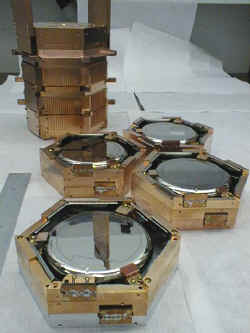No WIMPs in Sight

Perhaps 80% of the matter in the Universe is dark matter, made of some exotic particles, according to cosmologists. In the 19 June PRL the US-based CDMS collaboration reports on their decade-long effort to detect a candidate for dark matter known as WIMPs (weakly interacting massive particles). With a highly sensitive technique using detectors cooled to 0.02 K, they exclude the existence of WIMPs over a wide range of parameters. Their data are inconsistent with the WIMP detection claimed by an Italian-based collaboration earlier this year.
Of the various particles proposed to constitute dark matter, WIMPs have what CDMS co-spokesman Blas Cabrera of Stanford University calls a “double plus”–they are favored from two different directions. WIMP particles 50 to 100 times the mass of the proton could have survived since the big bang if they interact weakly with one another, avoiding particle-antiparticle annihilations that would have reduced their population. At the same time, this required interaction cross section (likelihood of interaction) is close to the value expected for a still undetected particle predicted by supersymmetric theories–currently the most popular proposals for unifying relativity with quantum mechanics.
The idea is that WIMPs, like neutrinos, may be everywhere around us, yet interacting with other matter only very rarely. In our galaxy there may be one WIMP in every of space. To search for these possibly common but elusive particles, the CDMS (Cryogenic Dark Matter Search) collaboration, which includes 11 US institutions, uses detectors made of silicon and germanium crystals surrounded by electrodes that pick up two different types of signals. For each particle (WIMP or “background”) that enters the crystals and hits an atom, the system registers both a slight temperature jump and the number of electron-hole pairs created by the recoiling nucleus or electron as it plows through the crystal. Comparing the two signals allows the team to rule out the majority of cosmic rays and radiation from nuclear isotope decays that might otherwise look like WIMPs.
After more than a year of taking data from these detectors, located 35 feet (11 m) underground at Stanford University, the CDMS collaboration says they have excluded the existence of WIMPs with the highest sensitivity ever reported. They recorded 17 events that were not clearly identified as background, but based on computer simulations and statistical arguments the team says that all 17 were most likely neutrons, not WIMPs. The team has begun construction of an experiment at the Soudan mine in Minnesota, 2700 feet (800 m) underground, where they expect to essentially eliminate such neutrons, which are created by energetic cosmic rays. CDMS II should be 100 times more sensitive and cover a much larger range of parameters allowed by supersymmetric theories.
In February an Italian and Chinese team (DAMA) announced evidence for a WIMP based on several years of data from NaI detectors inside a mountain in Italy. The CDMS results are “incompatible” with those of DAMA, within the framework of supersymmetry, according to CDMS spokesman Bernard Sadoulet of the University of California at Berkeley.
Neil Spooner of Sheffield University in the UK, spokesman for the UKDMC WIMP search collaboration, says that while the CDMS team has done a “thorough” job of analysis, nagging doubts remain regarding the 17 events labeled as neutrons. If one or two of them were WIMPs, he says, the statistical analysis would not catch them. At the same time, he has other concerns about the DAMA results. Spooner calls the CDMS approach “a very powerful technique” and looks forward to the team’s Soudan data in the next few years.


